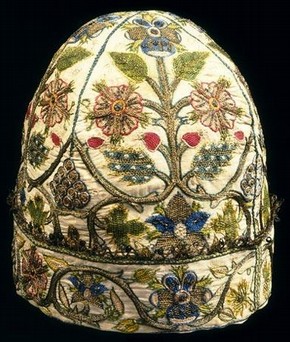
Man's
embroidered nightcap, linen with coloured silk, spangles, silver-gilt
thread and bobbin lace, England, 1600-1624, Museum no. T.258-1926
Introduction
This resource is intended for secondary Art & Design and Design & Technology teachers. It contains information about plant motifs in textiles from Tudor England, Mughal India and Qing China. There are ideas about different ways of looking at objects in the Victoria and Albert Museum, as well as suggestions on preparing for your visit and follow-up activities. You will find sections on the following:- About plant motifs
- Plant motif projects
- Find out more
- Botanical illustration resource box
About plant motifs
How does a motif move between cultures?
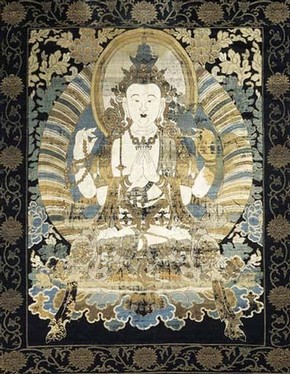 Plant ornament on textiles travelled extensively through trade,
colonialism and the spread of religions. In 1498 Vasco de Gama
discovered the sea route to India and in 1600 the East India Company was
established to control trade between Britain and the East. Its imports
included porcelain and silk from China, lacquer from Japan and cotton
textiles from India.
Plant ornament on textiles travelled extensively through trade,
colonialism and the spread of religions. In 1498 Vasco de Gama
discovered the sea route to India and in 1600 the East India Company was
established to control trade between Britain and the East. Its imports
included porcelain and silk from China, lacquer from Japan and cotton
textiles from India.
Such was the demand for these new and exotic goods that craftsmen
in Europe set out to imitate them, in a style known as 'Chinoiserie'.
But many of the imported goods had been made specifically for a European
market. Their designs had been adapted to suit western tastes and were
not an accurate reflection of Indian or Chinese design. Instead, they
created a romantic idea of the East that had little to do with reality.
The influence of trade and colonialism is particularly striking in the case of Britain and India. The colonisation of the subcontinent began as a trading relationship. Initially, the British bought chintz and other textiles to use as barter in the spice trade with the East Indies, but there was soon a growing demand on the European market for Indian fabrics, in both dress and furnishings.
An example of a motif travelling through religion is the lotus flower. It originated in India and reached China through the spread of Buddhism, with which it was closely associated.
Herbs, fruit and flowers in English embroidery
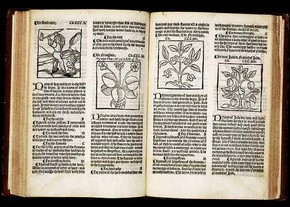 In England, embroidery was specially popular in the Tudor period
(1485-1603). It was worked professionally, by both men and women, and
also in the home, where it was seen as a refined activity suitable for
well-off, educated women.
In England, embroidery was specially popular in the Tudor period
(1485-1603). It was worked professionally, by both men and women, and
also in the home, where it was seen as a refined activity suitable for
well-off, educated women.
Plant motifs were common, reflecting the widespread interest in horticulture. One of the main sources of plant motifs for Tudor embroiderers were 'herbals', which contained descriptions and illustrations of herbs, flowers, fruit and other plants. Compiled by botanists and specially trained artists, herbals were used by apothecaries and gardeners as well as designers. Embroiderers would often copy a plant from a herbal, showing it in fruit and flower and completing the design with insects. There was no regard for scale or season.
Pattern books, both printed and drawn, were another source for plant motifs.
They showed a design repeat or ornamental motif that could be used in a variety of different media, not just embroidery. Motifs clearly derived from the same source can be found on objects made in very different materials.
 The amateur embroiderer would often engage a professional
'broderer' (embroiderer) to help her design and start the work. Motifs
were selected from pattern books, herbals and other sources, then
assembled into a design and drawn out on paper or parchment. The 'prick
and pounce' method was used to transfer the design onto the fabric.
Small holes were pricked along the main lines of the design, then chalk
mixed with charcoal was shaken (pounced) through them. To make the
design easier to follow, the dots were blended into a line using a wet
brush. The main lines were embroidered first, then the other areas of
the motif were filled in, often with counted thread work. In this
technique, the stitches were formed over a set number of ground fabric
threads, using the paper or parchment design as a guide.
Some of the most frequently used plant motifs were sweet pea pods,
pansies, roses, strawberries in fruit and flower, honeysuckle, grapes
and vine leaves. These can all be found on objects in the British
Galleries. Particularly interesting is a piece of blackwork (white linen
worked with black silk) called The Shepheard Buss ('buss' means 'kiss'
in 17th-century English).
The amateur embroiderer would often engage a professional
'broderer' (embroiderer) to help her design and start the work. Motifs
were selected from pattern books, herbals and other sources, then
assembled into a design and drawn out on paper or parchment. The 'prick
and pounce' method was used to transfer the design onto the fabric.
Small holes were pricked along the main lines of the design, then chalk
mixed with charcoal was shaken (pounced) through them. To make the
design easier to follow, the dots were blended into a line using a wet
brush. The main lines were embroidered first, then the other areas of
the motif were filled in, often with counted thread work. In this
technique, the stitches were formed over a set number of ground fabric
threads, using the paper or parchment design as a guide.
Some of the most frequently used plant motifs were sweet pea pods,
pansies, roses, strawberries in fruit and flower, honeysuckle, grapes
and vine leaves. These can all be found on objects in the British
Galleries. Particularly interesting is a piece of blackwork (white linen
worked with black silk) called The Shepheard Buss ('buss' means 'kiss'
in 17th-century English).
It shows a young man surrounded by plants and animals. The inscription around the edge suggests that he has been disappointed in love and so is in a melancholy frame of mind, though much of the symbolism is very obscure and open to debate. A pastoral retreat - to study, compose music or simply contemplate - was considered essential to the development of a refined young man. It features in Shakespeare's 'As You Like It' and other plays of the period.
Flowering plants in Indian chintz
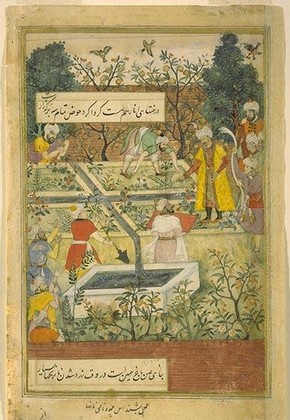 The display in the South Asia gallery (Room 41) concentrates on
Indian art from the Mughal period (1525-1858). Many of the objects
include floral designs because the Mughal emperors loved nature. This
miniature with a decorative floral border shows Babur, founder of the
Mughal empire, who was responsible for many beautiful gardens.
Gardens occupy a special place in Islam. They are closely related
to the concept of paradise, which the Qur'an describes as a wet, shady,
spacious and beautiful garden. Paradise is formal in character and
includes not only an abundance of flowering and fruit-laden trees, but
also shimmering fountains and rivers.
The display in the South Asia gallery (Room 41) concentrates on
Indian art from the Mughal period (1525-1858). Many of the objects
include floral designs because the Mughal emperors loved nature. This
miniature with a decorative floral border shows Babur, founder of the
Mughal empire, who was responsible for many beautiful gardens.
Gardens occupy a special place in Islam. They are closely related
to the concept of paradise, which the Qur'an describes as a wet, shady,
spacious and beautiful garden. Paradise is formal in character and
includes not only an abundance of flowering and fruit-laden trees, but
also shimmering fountains and rivers.
Another factor in the use of floral imagery was the trade between India and Europe. This can be seen especially in the painted cottons (chintz) made in India for the European market. Their brilliant colours, exuberant floral patterns and fast dyes made them very popular in 17th- and 18th-century Europe. To create goods that would sell on the European market, Indian textile workers borrowed design motifs from western sources. In the palampore, the stylised tree and leaves show the influence of European textiles, especially the tapestry and embroidery of the early 17th century.
In Room 56c in the British Galleries there are two contrasting chintzes with flowering-tree motifs, one English and the other Indian. This flowering tree motif was a particularly popular and recurring image on export chintz. It usually consisted of a tree with a serpentine trunk, entwined branches and highly stylised leaf motifs.
 The manufacture of an elaborate, multi-coloured hanging or
bedspread was a complicated undertaking. It involved many different
processes and could take months to complete. The equipment was quite
simple but the workers were highly skilled. Their techniques of dyeing
and painting cloth were much more advanced than those used in Europe at
that period.
The dyeing required mordants (metallic compounds that formed a
chemical 'bridge' between the cloth and the dye), along with resist
techniques to prevent the dye penetrating certain areas of the design.
The manufacture of an elaborate, multi-coloured hanging or
bedspread was a complicated undertaking. It involved many different
processes and could take months to complete. The equipment was quite
simple but the workers were highly skilled. Their techniques of dyeing
and painting cloth were much more advanced than those used in Europe at
that period.
The dyeing required mordants (metallic compounds that formed a
chemical 'bridge' between the cloth and the dye), along with resist
techniques to prevent the dye penetrating certain areas of the design.
Before dyeing, the design was pounced or drawn onto the fabric. Then the cloth was put in a series of red and blue dyebaths. If the dyebath was red, the areas that were to be coloured were first painted with a brush dipped in mordant. Where there was no mordant, the dye would did not adhere to the fabric. By adjusting the mordants in the red dyebath a range of shades could be produced. A weak alum mordant gave pink and a stronger one deep burgundy. An iron mordant gave purple to black.
Blue was produced from indigo, which does not need a mordant. To protect parts of the design from the dye, beeswax was painted on to the cloth, as in batik.
There were no good dyes for green so the last stage of the dyeing process was to paint yellow dye over the blue to make green. Unfortunately the yellow tends to fade, so green leaves are often now blue as you can see in this floor spread.
Symbolic plants in Chinese textiles
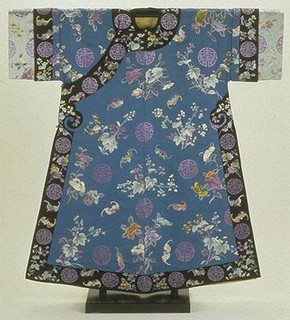 Apart from a man's robe which may be as recent as 1930, all the
textiles in the China gallery (Room 44) date from the Qing (pronounced
'Ching' ) dynasty (1644-1911).
Apart from a man's robe which may be as recent as 1930, all the
textiles in the China gallery (Room 44) date from the Qing (pronounced
'Ching' ) dynasty (1644-1911).
The decorative motifs used on Chinese textiles almost invariably have a meaning that would have been understood at the time they were made. The meanings of Chinese plant symbols have a variety of sources. Sometimes they are based on myths, legends or traditions. The peach, symbol of long life, is a good example of a symbol based on a legendary plant, in this case the peach tree of immortality - which stood in the gardens of the fairy goddess Xi-wang-mu, the Royal Mother of the West.
Very often, the meaning of a symbol is derived from a verbal pun, in which different words sound similar when spoken. For instance, there is a phonetic similarity between 'chrysanthemum' and 'to remain' in Chinese. In addition, the chrysanthemum is the flower of the ninth month of the old Chinese calendar, and 'nine' and 'long time' sound identical. Consequently, the symbolic meaning of the chrysanthemum is 'long life and endurance'.
The characteristics and properties of some plants determine their symbolic meaning. The pine tree represents 'long life and steadfastness' because it can withstand cold and does not shed all its needles at once.
The social context for symbols was particularly important in traditional Chinese culture, and plant motifs were often used to communicate something in a situation where words would have been regarded as unsophisticated. For instance, there is a woman's robe in the China gallery that was probably given as a birthday gift. Its symbols convey birthday wishes: bats for happiness, peonies for wealth and distinction, and chrysanthemum, the Chinese character for 'long life'.
Most of the plant motifs used on Chinese textiles are fairly stylised. This is because they are mainly embroidered, and the techniques and style favoured by the Chinese did not offer much scope for naturalism, however skilled the embroiderer.
One of the hallmarks of Chinese embroidery is satin stitch, in which straight stitches are worked closely together to fill a solid shape. Shading is achieved through 'encroaching', whereby one line of stitches breaks into the next, which is of a lighter or darker tone of the same colour. Every new stitch is positioned between the bases of the two on the row before. Nonetheless, the individual colours do not merge in the way they might if they were painted.
Although some subtlety is possible with encroaching, the Chinese habit of leaving a thin line of unembroidered material between each motif or area (voiding) creates an outline effect that adds to the overall stylisation.
The pared-down nature of Chinese pictorial conventions also influenced the rather abstract appearance of the textiles. In China, botanical sources such as herbals do not seem to have been used, as they were in England and India. Certainly by the 19th century, Chinese embroiderers were using standardised plant motifs from pattern books. They transferred them to the fabric either by tracing, or by the 'prick and pounce' technique familiar to English embroiderers and Indian textile workers.

Woven Buddhist picture, woven silk, China, about 1740-1800 (Qing Dynasty), Museum no. T.97-1966
The influence of trade and colonialism is particularly striking in the case of Britain and India. The colonisation of the subcontinent began as a trading relationship. Initially, the British bought chintz and other textiles to use as barter in the spice trade with the East Indies, but there was soon a growing demand on the European market for Indian fabrics, in both dress and furnishings.
An example of a motif travelling through religion is the lotus flower. It originated in India and reached China through the spread of Buddhism, with which it was closely associated.
Herbs, fruit and flowers in English embroidery

'The Great Herbal', book with woodcut illustrations, printed by Peter Treveris, 1526, Museum no. L.1059-1901
Plant motifs were common, reflecting the widespread interest in horticulture. One of the main sources of plant motifs for Tudor embroiderers were 'herbals', which contained descriptions and illustrations of herbs, flowers, fruit and other plants. Compiled by botanists and specially trained artists, herbals were used by apothecaries and gardeners as well as designers. Embroiderers would often copy a plant from a herbal, showing it in fruit and flower and completing the design with insects. There was no regard for scale or season.
Pattern books, both printed and drawn, were another source for plant motifs.
They showed a design repeat or ornamental motif that could be used in a variety of different media, not just embroidery. Motifs clearly derived from the same source can be found on objects made in very different materials.

'The Shepheard Buss' wall hanging, linen embroidered with silk and bobbin lace border, England, 1570-1600, Museum no. T.219-1953
It shows a young man surrounded by plants and animals. The inscription around the edge suggests that he has been disappointed in love and so is in a melancholy frame of mind, though much of the symbolism is very obscure and open to debate. A pastoral retreat - to study, compose music or simply contemplate - was considered essential to the development of a refined young man. It features in Shakespeare's 'As You Like It' and other plays of the period.
Flowering plants in Indian chintz

'Babur
supervising the laying out of the Garden of Fidelity', illustration
from a Mughal book of manuscripts, watercolour and gold on paper, India
or Pakistan, about 1590, Museum no. IM.276-1913
Another factor in the use of floral imagery was the trade between India and Europe. This can be seen especially in the painted cottons (chintz) made in India for the European market. Their brilliant colours, exuberant floral patterns and fast dyes made them very popular in 17th- and 18th-century Europe. To create goods that would sell on the European market, Indian textile workers borrowed design motifs from western sources. In the palampore, the stylised tree and leaves show the influence of European textiles, especially the tapestry and embroidery of the early 17th century.
In Room 56c in the British Galleries there are two contrasting chintzes with flowering-tree motifs, one English and the other Indian. This flowering tree motif was a particularly popular and recurring image on export chintz. It usually consisted of a tree with a serpentine trunk, entwined branches and highly stylised leaf motifs.

Part
of a chintz floor spread made for the Mughal court, resist and mordant
dyed cotton, India, late 17th or early 18th century, Museum no.
IM.69-1930
Before dyeing, the design was pounced or drawn onto the fabric. Then the cloth was put in a series of red and blue dyebaths. If the dyebath was red, the areas that were to be coloured were first painted with a brush dipped in mordant. Where there was no mordant, the dye would did not adhere to the fabric. By adjusting the mordants in the red dyebath a range of shades could be produced. A weak alum mordant gave pink and a stronger one deep burgundy. An iron mordant gave purple to black.
Blue was produced from indigo, which does not need a mordant. To protect parts of the design from the dye, beeswax was painted on to the cloth, as in batik.
There were no good dyes for green so the last stage of the dyeing process was to paint yellow dye over the blue to make green. Unfortunately the yellow tends to fade, so green leaves are often now blue as you can see in this floor spread.
Symbolic plants in Chinese textiles

Woman's birthday robe, embroidered silk, China, 1870-1911 (Qing dynasty), Museum no. T.231-1948
The decorative motifs used on Chinese textiles almost invariably have a meaning that would have been understood at the time they were made. The meanings of Chinese plant symbols have a variety of sources. Sometimes they are based on myths, legends or traditions. The peach, symbol of long life, is a good example of a symbol based on a legendary plant, in this case the peach tree of immortality - which stood in the gardens of the fairy goddess Xi-wang-mu, the Royal Mother of the West.
Very often, the meaning of a symbol is derived from a verbal pun, in which different words sound similar when spoken. For instance, there is a phonetic similarity between 'chrysanthemum' and 'to remain' in Chinese. In addition, the chrysanthemum is the flower of the ninth month of the old Chinese calendar, and 'nine' and 'long time' sound identical. Consequently, the symbolic meaning of the chrysanthemum is 'long life and endurance'.
The characteristics and properties of some plants determine their symbolic meaning. The pine tree represents 'long life and steadfastness' because it can withstand cold and does not shed all its needles at once.
The social context for symbols was particularly important in traditional Chinese culture, and plant motifs were often used to communicate something in a situation where words would have been regarded as unsophisticated. For instance, there is a woman's robe in the China gallery that was probably given as a birthday gift. Its symbols convey birthday wishes: bats for happiness, peonies for wealth and distinction, and chrysanthemum, the Chinese character for 'long life'.
Most of the plant motifs used on Chinese textiles are fairly stylised. This is because they are mainly embroidered, and the techniques and style favoured by the Chinese did not offer much scope for naturalism, however skilled the embroiderer.
One of the hallmarks of Chinese embroidery is satin stitch, in which straight stitches are worked closely together to fill a solid shape. Shading is achieved through 'encroaching', whereby one line of stitches breaks into the next, which is of a lighter or darker tone of the same colour. Every new stitch is positioned between the bases of the two on the row before. Nonetheless, the individual colours do not merge in the way they might if they were painted.
Although some subtlety is possible with encroaching, the Chinese habit of leaving a thin line of unembroidered material between each motif or area (voiding) creates an outline effect that adds to the overall stylisation.
The pared-down nature of Chinese pictorial conventions also influenced the rather abstract appearance of the textiles. In China, botanical sources such as herbals do not seem to have been used, as they were in England and India. Certainly by the 19th century, Chinese embroiderers were using standardised plant motifs from pattern books. They transferred them to the fabric either by tracing, or by the 'prick and pounce' technique familiar to English embroiderers and Indian textile workers.
No comments:
Post a Comment